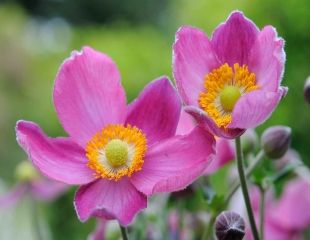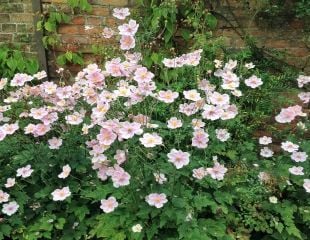


How to Grow Japanese Anemones
Japanese anemones are a late summer flowering shade tolerant perennial. They have saucer like flowers in shades of pink, white and cream and many varieties offered for sale are tall, 75cms plus ideal for planting towards the back of a boarder. Once established, Japanese anemones are easy to grow and maintenance free. Their leaves are almost silky in appearance, and they are long flowering from August through to October.
Despite being on the tall side, Japanese anemones do not need staking unless grown in an exposed spot. Not unsurprisingly, as its common name is windflower. They require no pruning, and it is not even necessary (although it may be preferable from the aesthetic point of view,) to deadhead them. Japanese anemones are a low maintenance plant and I have tagged them green wheelbarrow.

The advantage of growing Japanese Anemones is that they will grow in partial and deep shade and even shade which is on the dry side. A tough grow anywhere plant.
Ideal for tricky, shady areas of the garden, but beware, they are vigorous. You will never have just two or three plants! It is best not to plant them in an area where spread may be a problem and wherever you plant them (unless it's a big stately home sized border,) inevitably you will need to dig out surplus plants.
In the image are Japanese Anemones growing in a garden I have recently moved into. The previous owners had planted the Anemones and left them to their own devices. There is a large clump growing in front of the trellis, but also a similar large clump has established itself the other side of the trellis, just out of camera. In addition, the Japanese Anemones have also self seeded themselves all along a border close to the side of the house in deep shade.
Japanese anemones are worth growing for their pretty flowers and because they will flourish in shade, but it is best to keep them in check reducing to a tidy clump. There is a lot to dig out here in order to make space for some other plants.
Where to plant Japanese Anemones
The ideal growing conditions for Japanese anemone is in a spot with partial shade so that plants do not get too hot. Grow in soil which is well-drained soil and which does not become water-logged. Plants which are too wet over winter may not survive. If your garden is on the cold side, a winter mulch may help. Japanese will grow in partial shade, they will tolerate dense shade but may flower less, and also dry shade, which makes them a useful plant for difficult areas.
It can take a little time to get Japanese anemones established, but once they start flowering, they will do so reliably every year, and for a long flowering season. Japanese anemones are ideal for late colour in the border. Japanese anemones are among the longest-blooming and longest-lived perennials, remaining undisturbed in your garden for years.
The first frosts turn the foliage black, and at this stage, one can cut back the plants for the winter.
If planted in partial shade, Japanese anemones look good with tall ferns and the larger varieties of Hosta. They will also mix well with other late flowering perennials such as Asters, Sedum, and the tall Verbena bonariensis. Illustrated below is a lovely planting combination with grasses.
Which varieties of Japanese Anemones to plant
It is often best to start with plants which have the RHS award of garden merit which is a guide to getting plant which is a good all round performer.
Anemone × hybrida 'Elegans' is a tall pale pink variety illustrated in the centre image.
Anemone Japenese anenome hupehensis Pamina is a darker pink and illustrated on the left.
Anemone Honorine Jobert is a lovely white variety illustrated left all three have the RHS award.
Also with the RHS award not illustrated is Anemone hupehensis 'Bowles's Pink', Anemone hupehensis 'Hadspen Abundance' also pink,
Anemone × hybrida 'Königin Charlotte', a delicate light pink.
Suttons have a lovely selection of Japanese Anemones for sale ( affiliate link) including a collection of soft pink, magenta and cream blooms and the curiously name A. Frilly Knickers.

I have tagged Japanese Anemones as green wheelbarrow because they are easy to grow (perhaps too easy) and maintenance free.
